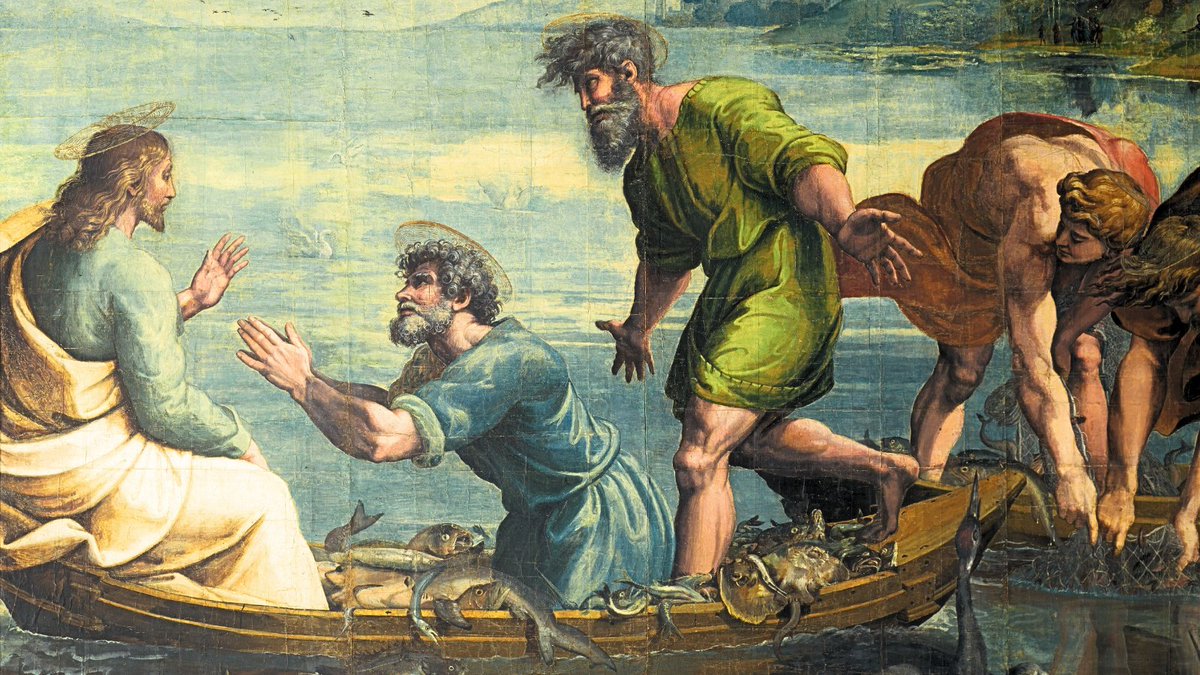Why did Jesus SPECIFICALLY tell the disciples to cast the net on the right side of the boat?
This wasn't fishing advice.
Once you understand what 'right side' really means, everything changes about following divine direction (thread) 🧵 ...
This wasn't fishing advice.
Once you understand what 'right side' really means, everything changes about following divine direction (thread) 🧵 ...

Peter and the other disciples fish all night but catch nothing.
Jesus shouts, "Cast your net on the right side." They obey and catch so many fish they can't haul the net in.
Jesus shouts, "Cast your net on the right side." They obey and catch so many fish they can't haul the net in.

Here’s the secret symbolism:
• The right represents gathering toward the center, like catching fish
• The left represents moving away from the center, like sowing seed.
Christ commands them to fish from the side of gathering.
• The right represents gathering toward the center, like catching fish
• The left represents moving away from the center, like sowing seed.
Christ commands them to fish from the side of gathering.

The symbolism goes deeper:
Peter embodies the right hand. He is the apostle who gathers.
Christian art shows the Church as a boat. Noah gathered the animals, like Peter gathers fish.
The nave (meaning "boat") where the faithful stand connects to this ancient ark symbolism.
Peter embodies the right hand. He is the apostle who gathers.
Christian art shows the Church as a boat. Noah gathered the animals, like Peter gathers fish.
The nave (meaning "boat") where the faithful stand connects to this ancient ark symbolism.

The fish symbolize principles hidden in dark waters - sparkling living things found inside the chaos.
The early Christian fish symbol showed how nourishment can be found in the salty waters of death.
The early Christian fish symbol showed how nourishment can be found in the salty waters of death.

Chaotic waters represent death, the primordial ocean, passions, and doubt.
But fishing means bringing out of death and chaos things which are useful and precious.
Peter, as the founder of the Church, is the cosmic fisherman.
But fishing means bringing out of death and chaos things which are useful and precious.
Peter, as the founder of the Church, is the cosmic fisherman.

But why cast the net on the right side?
Because Peter is the Church’s right hand. He symbolizes unity and stability.
As axis and center, he gathers the faithful (fishing for men), giving them a home in the divine order and holding the Church together.
Because Peter is the Church’s right hand. He symbolizes unity and stability.
As axis and center, he gathers the faithful (fishing for men), giving them a home in the divine order and holding the Church together.

But Peter’s right-hand authority carries a danger.
Because he embodies unity, he may see himself as self-sufficient. The sin of the right hand is to mistake the unity and order it creates for totality, believing it can stand without God.
Because he embodies unity, he may see himself as self-sufficient. The sin of the right hand is to mistake the unity and order it creates for totality, believing it can stand without God.

Peter needs Paul, the apostle to the Gentiles.
Paul is the Church’s left hand, the traveler and shapeshifter. He becomes "all things to all men" to spread the message across foreign lands.
Paul carries the faith outward, extending the Church beyond its center.
Paul is the Church’s left hand, the traveler and shapeshifter. He becomes "all things to all men" to spread the message across foreign lands.
Paul carries the faith outward, extending the Church beyond its center.

But Paul needs Peter too.
Alone, the left hand risks drifting. Its adaptability and wandering can lose focus and scatter. What drives expansion can become aimless if not firmly rooted in the center.
But when should we be Peter, and when should we be Paul?
Alone, the left hand risks drifting. Its adaptability and wandering can lose focus and scatter. What drives expansion can become aimless if not firmly rooted in the center.
But when should we be Peter, and when should we be Paul?

Be Peter when your community needs foundations, unity, and stability.
When people are scattered and need gathering into a center. When chaos threatens, and someone must be the unmovable axis around which others can find their place.
When people are scattered and need gathering into a center. When chaos threatens, and someone must be the unmovable axis around which others can find their place.

Be Paul when the message needs to reach new territories.
When rigid structures have become barriers. When you must adapt and become "all things to all men" to carry truth across boundaries the center cannot cross.
When rigid structures have become barriers. When you must adapt and become "all things to all men" to carry truth across boundaries the center cannot cross.

It’s a sacred balance.
Every thriving church, family, or community depends on both.
The left and right hands must work together, serving the same body.
Every thriving church, family, or community depends on both.
The left and right hands must work together, serving the same body.

In each moment, we need to ask ourselves:
Is this a time for gathering or scattering? For strengthening the center or expanding the periphery?
The same Christ who commands, "fish on the right side," also sends apostles to the ends of the earth.
Is this a time for gathering or scattering? For strengthening the center or expanding the periphery?
The same Christ who commands, "fish on the right side," also sends apostles to the ends of the earth.

If you enjoyed this thread, you'll love the newsletter.
Weekly deep-dives into Scripture (link in bio).
Weekly deep-dives into Scripture (link in bio).

• • •
Missing some Tweet in this thread? You can try to
force a refresh






















